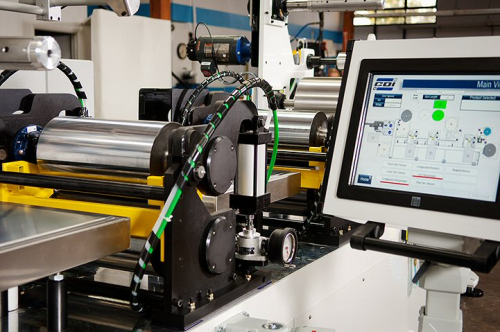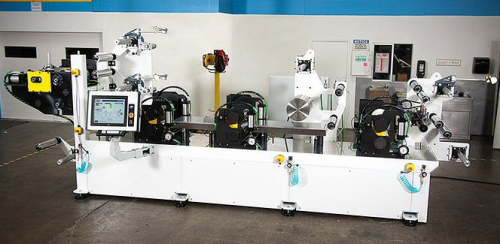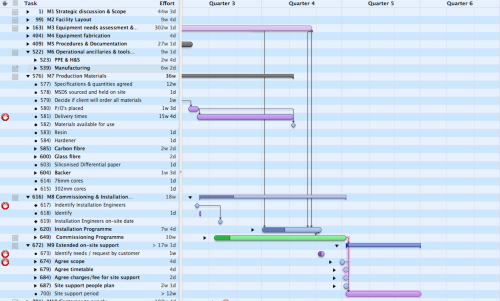


CDI, headquartered in San Diego, California, developed its first carbon fibre prepreg machine in the early 1960s to support the NASA lunar lander. Today, it has a full line of prepreg machines, ranging from its recently upgraded small production prepreg machine (the CD6015 Combi) to large high volume machines for industrial prepreg production.
CDI was also involved in the development of the carbon composites market, manufacturing products ranging from golf club shafts and fishing rods, to wind turbine blades and aerospace products.
“It's this extensive knowledge of the manufacturing process that allows CDI to design machines that are cost effective and have a proven reliability and performance record unrivalled in the composite industry,” claims McConnell, who acquired the company in February 2011.
Since the acquisition, McConnell has built on CDI’s strong reputation and reliable machines. His is focussing on making the equipment easier to operate and this is being achieved in a number of ways:
- adding full automation;
- providing more options to best fit customers’ needs e.g. creels to rewinder enhancements;
- incorporating a full support package including machines (hardware) and processing support (software); and
- provision of TIP™ (Total Integration Program), a comprehensive management program delivering the design, technology and implementation for advanced composite material manufacturing facilities.
Easier to use machines
"Like most production machines, prepreg machines are becoming more sophisticated, automated and increasing their data collection capabilities," McConnell reports. "Companies are looking for easier to use machines, higher outputs, and lower cost processing."
|
Like most production machines, prepreg machines are becoming more sophisticated, automated and increasing their data collection capabilities. Companies are looking for easier to use machines, higher outputs, and lower cost processing. |
| Keith McConnell, president, CDI |
Cost of materials is always a key focus for the composites industry, he notes, and the imminent increase in new carbon fibre manufacturers entering the market will be driving the fibre costs lower.
"However much of this new fibre is difficult to process and utilise as it exhibits large variations in its condition and consistency," McConnell says, "and this is driving a need for machines to be more ‘fibre friendly,’ which has been the core of CDI designs for the last 35 years."
There is also a large number of new manufacturing customers entering the market. This is driving a need for machine designs that are easier to operate along with strong technical support to enable customers to learn to utilise the machines to produce high quality, cost effective prepreg for their end product.
CDI introduced its TIP technology support package at the China Composites Expo in 2011 and McConnell reports that response to this has been very good. Primarily focused around prepreg manufacturing operations and related downstream activities, the TIP program is based on 10 modules which provide all elements of prepreg processing, from strategic market determination and facility layouts, to training on machine operation and material qualification. Each TIP program is custom designed for the customer’s market, product and volume needs.
A growing trend for smaller prepreg machines
CDI had been supplying a small production prepreg machine for many years, which was targeted at research and laboratory customers. This machine has been redesigned and earlier this year it was launched at the JEC Europe 2012 exhibition as the CD6015 Combi.
“This machine supports resin filming and prepreg processing and its development was driven by the explosion of small users who wanted better control of their processes and materials, but were not interested in becoming prepreg experts or spending a lot of money to develop another option,” explains McConnell.
The CD6015 Combi machine is designed to deliver two primary functions:
- an R&D tool for fibre and resin matrix development; and
- a small volume production machine for manufacture of unidirectional prepregs.
For R&D applications the machine offers rapid product changes, has limited infrastructure requirements, and has sufficient capacity and capability for producing narrow sample materials for use in manufacturing intermediate sized, prototype components.
As a small volume production machine the CD6015 Combi can address continuity of existing supply issues for small unidirectional prepreg users, it can reduce lead time ('just in time' manufacturing), it can produce custom unidirectional prepreg materials not commercially viable in small volumes, and it can provide direct material cost savings for some applications.
"CDI’s CD6015 Combi machine will allow smaller companies to develop their own high quality prepreg and supporting physical properties to utilise in either the manufacturing of their own composite products, or in the sales of their fibre or matrix materials," explains McConnell.
Technology partner
CDI is continuing to refine its prepreg machines.
"We aim to make them easier to use, adding additional options to allow machines to be perfectly tuned to each customer’s requirements, lowering the cost of machine operation, and reducing machine lead times to allow customers to meet tight schedules," McConnell states. "We have introduced improved spreading technology, open architecture, automated creels, a high capacity prepreg machine for the wind power and industrial materials market and are developing a machine specifically for the production of thermoplastic matrix prepregs."
"The main focus of our efforts is to allow customers to produce and process prepreg with machines that are 'fit for purpose' by focusing on the real requirements and not adding anything that isn’t required or doesn’t add value," he continues. "Our focus is to help our customers make money with our machines, not just have a high performance machine which they can’t operate to their standards or doesn’t offer a satisfactory return on investment. We feel that this can only be achieved by providing a full support package and working as a 'technology partner' with our customers for both the equipment and processing support to produce the highest quality prepreg at the lowest overall cost."
Market demand
McConnell reports that business is currently good.
“Business is remaining very strong, with solid requirements coming from Asia, particularly China and Korea,” he says. “I am pleased to report demand in India is also beginning to strengthen. JEC Paris was successful for us too this year, with a good response to our machines throughout Europe. American demand has returned and has grown significantly in the past six months.”
The expansion of its business network into China, India and the Middle East is a key objective for CDI.
In China, CDI has teamed up with ATA Carbon Fiber Tech. Guangzhou Co Ltd to setup a demonstration CD6015 Combi machine at its facility. This will allow potential customers to trial CDI’s latest equipment, receive prepreg production training, and learn how to convert their fibres or resins into suitable prepreg. They will also be able to produce sample materials.
Beyond prepreg
McConnell emphasises CDI's focus on the integration of technology with its customers to allow them to become competitive within the composites market.
|
Established: 1957 No. of employees: 31 Turnover: US$15 million Headquarters: San Diego, California, USA Sales offices: Isle of Wight, UK; Guangzhou and Tianjin, China |
"Initially we were focusing on the manufacturing and development of prepreg materials through our TIP program, but we are already moving to full support for the design and fabrication of composite products," he says. "Our TIP program is not just the application of our equipment, but the integration of all the materials and equipment required to produce, consistent, high quality, cost effective prepreg at production rates. We are therefore developing key alliances with equipment and materials suppliers to allow for a complete offering of the best value package for our customer’s prepreg manufacturing requirements."
"Our strategic alliance with ATA is in support of an Advanced Composites Innovation Hub (ACIH), which will offer a full range of support solutions to customers from new resin and fibre manufacturers," McConnell explains. "This will allow them to develop processes and properties for their materials, and composite product manufacturers will have access to complete prepreg processing, through to the production of finished structural composite parts." ♦
This feature was published in the July/August 2012 issue of Reinforced Plastics magazine.
The digital edition of Reinforced Plastics is distributed free of charge to readers who meet our qualifying criteria. You can apply to receive your free copy by completing the registration form.





